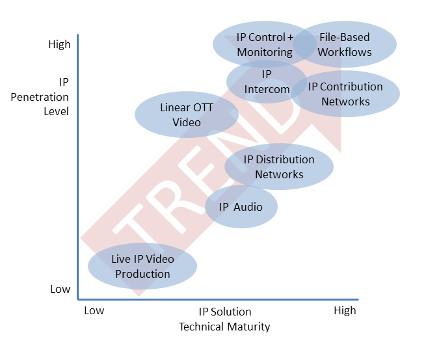Challenges Remain for Live IP Production
ORANGE, CONN.—IP technology is already driving major improvements in live video production. New standards such as SMPTE ST 2110 will further cement IP’s role as the dominant production format.
Ask any broadcaster today which network formats are currently used for signal transport, and the answer will no doubt include IP (Internet Protocol) networking, in many cases at the top of the list. IP’s benefits are widely acknowledged, including great flexibility, low cost, and widespread availability. These factors would seem to make it an ideal choice for live video production, right?

Current deployment level of several IP technologies used in live productions
Well, reality is a little more complicated. While IP has greatly improved live production workflows, most of the impact has been confined to signals other than the transport of actual video, particularly within the studio. That is not to diminish the benefits of IP, it simply means that video is the last holdout prior to completing the migration to IP. To understand how far the industry has progressed towards IP, it helps to look at each of the major functions individually.
MAKING THE CONTRIBUTION
IP technology has made major inroads into live video production, and one of its major impacts has been in contribution links, spanning the distance from remote venues back to production studios. A majority of these circuits use compression at high bit rates, in the range of 20 to 200 Mbps. Technologies such as H.264, I-frame only H.264 (also called AVC-I), and JPEG 2000 are popular contribution formats. In many cases, these signals will flow over IP network connections, either as part of a larger IP pipe or on special leased circuits.
Uncompressed contribution links are also available, particularly from special video networking providers. But most uncompressed services currently use SDI interfaces for connections at signal sources and destinations, even though the signals are often carried over IP networks internally to the carrier. Remote productions will need to transition to using high-bandwidth IP connections (over 1 Gbps) in order to support end-to-end uncompressed IP video.
WITHIN THE STUDIO WALLS
With the completion of the first round of SMPTE ST 2110 standards for uncompressed elementary streams over IP, the stage is set for a major transition from SDI-based to IP-based signal flows within the live production studio. In order for this to happen, a few changes need to take place.
First and foremost, all of the devices that send, receive and process video need to be upgraded to handle ST 2110 video. As seen at this year’s NAB, IBC, and SMPTE shows, manufacturers are making major progress in developing products for all of the required ST 2110 functions, and the interop demos showed how well the various products work together. Next year will likely see an onslaught of product releases and sales, marking the beginning of the all-IP studio. Hybrid systems that support both SDI and ST 2110 will also have a role to play during the transition. However, the major benefits of IP-based system will not appear until a substantial majority of the equipment has been converted.
Studios will also need to install high-capacity Ethernet switches, with capacities in the Terabit per second range. IEEE 1588 Precision Time Protocol master clocks and infrastructure will need to be installed. While these upgrades are currently underway at some major networks, they will take time and consume a significant amount of capital before they become fully realized.
BEYOND VIDEO AND AUDIO
Aside from video, IP technology has already had a major impact on other signals used in live production. One example is intercom systems, which have pretty much abandoned expensive T1/E1 and ISDN telco circuits in favor of low-cost IP interfaces, particularly for wide area networks. IP networks are also growing in popularity for uncompressed audio transport using the AES 67 standard, particularly in cases where the audio signals are not embedded within SDI video signals.
Another application where IP networks are prevalent is in system control and monitoring. This can range anywhere from simple device status reporting to complete control of a live production in real time. Given the tiny bandwidths needed for these signals, the flexibility of IP systems provides huge benefits. Plus there are many non-realtime activities during live productions that can be implemented over IP, including e-mail, web-based research and other preparation. (Woe betide the OB van operator who can’t get a printer working in time for copies of the script to be made).
File transfer is one more area where IP technology clearly dominates. Most live productions today need all sorts of support in the form of graphic overlays, interstitials, archive clips, and other file-based content. IP networks are the perfect choice for transporting these files, whether within the studio or over long haul networks.
IP MOVING FORWARD
Although fully-IP live production systems are currently few and far between, that doesn’t mean that broadcasters haven’t been able to benefit from using the technology. Quite the contrary—many routine aspects of live productions have been migrated completely over to IP networks, delivering major benefits in efficiency and flexibility. These benefits themselves are sufficient to justify the move to IP.
The trend towards greater penetration of IP for media signals is unstoppable, and much to be desired. It will take some time, but in a few years, broadcasters will wonder how they ever managed to cope with multiple incompatible signal types, each of which required its own set of cabling, interfaces and synchronization systems. High-bandwidth, multiformat, reconfigurable IP infrastructure will become as indispensable as electricity for every media production.
Get the TV Tech Newsletter
The professional video industry's #1 source for news, trends and product and tech information. Sign up below.
Wes Simpson is President of Telecom Product Consulting, an independent consulting firm that focuses on video and telecommunications products. He has 30 years experience in the design, development and marketing of products for telecommunication applications. He is a frequent speaker at industry events such as IBC, NAB and VidTrans and is author of the book Video Over IP and a frequent contributor to TV Tech. Wes is a founding member of the Video Services Forum.

